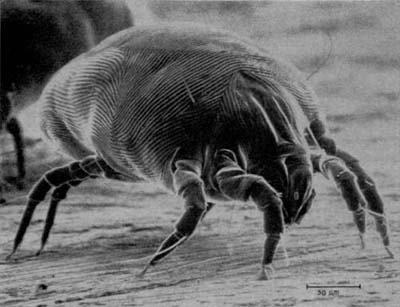 House Dust Mite Credit: Food and Drug Administration |
In Herman Melville’s classic novel “Moby Dick,” the white whale Ahab relentlessly hunted was so massive that flocks of birds would hover above it. Moby Dick was like a moving island, and an entire ecosystem had grown around its existence. Although we cannot see them with the naked eye, humans support colonies of microscopic organisms also.
The average human sheds 0.5 to 1.0 gram of skin daily, enough to support between hundreds of thousands and millions of dust mites living in our beds, eating our dead skin and soaking up the humidity in our respiration and perspiration, our breath and sweat. Like ticks and spiders, mites are arachnida, and each one produces an average of 20 faecal pellets per day, meaning every night when you lay your head down on your pillow, you stir up and inhale a cloud of mite poop.
While dust mites live in our beds and carpets, demodex mites take up residence on our bodies. These microscopic scaly, semi-transparent bugs live in our eyebrows, eyelashes, and nose hairs, feeding on the dead skin and oils that collect in our hair follicles with their pin-like mouth parts. Although the demodex has a digestive system that is so efficient and produces so little waste it doesn’t need an excretory orifice, their corpses are probably decomposing in your hair follicles and sebaceous glands right now.
While these bugs live on and around us, our entire bodies are made up of individual living units, Somatic Cells. Our skin, brain, liver, blood, heart, and myriad other cells have given up their ancestors’ single-celled way of living to collaborate on surviving as a multi-cellular form of life. Every single cell in your body has bet its survival and reproduction on your survival and reproduction.
For instance, our skin cells form a nice barrier around us, holding us together and protecting our insides from bacteria, ultraviolet rays, and dirt. They do this to keep us alive long enough to have offspring, who will also be covered with skin cells, and thus skin cells successfully reproduce through us. Here we think our skin cells are just being nice by wrapping up our bodies and valiantly defending us from the world, but really they’re just looking after their own self-interests.
Every cell in our body has its own inhabitants, producing the chemical energy that power them. These are mitochodria, and they reproduce by cell-division and have their own DNA separate from the DNA that makes up our cells. The mitochondria in our cells have the same DNA as the mitochondria in our mother’s cells, and her mother’s, and so on all the way back to “Mitochondrial Eve,” our matrilineal common ancestor who lived in Ethiopia around 140,000 years ago.
Although they cannot live outside of cells today, it is commonly believed that mitochodria were once independently living organisms, protobacteria, that survived being eaten or otherwise ingested by another cell. The cell, having its own power source provided by the mitochondria, was able to inhabit a much larger range of environments. The mitochodria got to hitch a free ride, reproducing inside their new hosts. It was the start of a beautiful, symbiotic relationship that has lasted for more than two billion years.
One step up from mitochondria in complexity are the microflora we carry around inside of us. Immediately after we are born, bacteria start taking up residence in our digestive tracks, primarily through nurturing contact with our mothers. These bacteria, which are more numerous than the cells in our bodies, help us to derive nutrients from foods we would otherwise be unable to digest, strengthen our immune systems, and prevent us from developing certain allergies.
They also protect us from harmful bacteria as well, starving them out of our personal ecosystems and producing toxins to poison the alien invaders. Every one of us supports a unique garden of micorflora, which interact and combat with every other person’s microbial colonies. The first kiss that seems so spine-tingling and unifying for a pair of young lovers is like World War III for the microflora in their guts and the somatic cells in their immune systems.
That is, until their microflora eventually even out with more kisses. : )
Notes:
Comments
10 responses to “Our Personal Ecosystems”